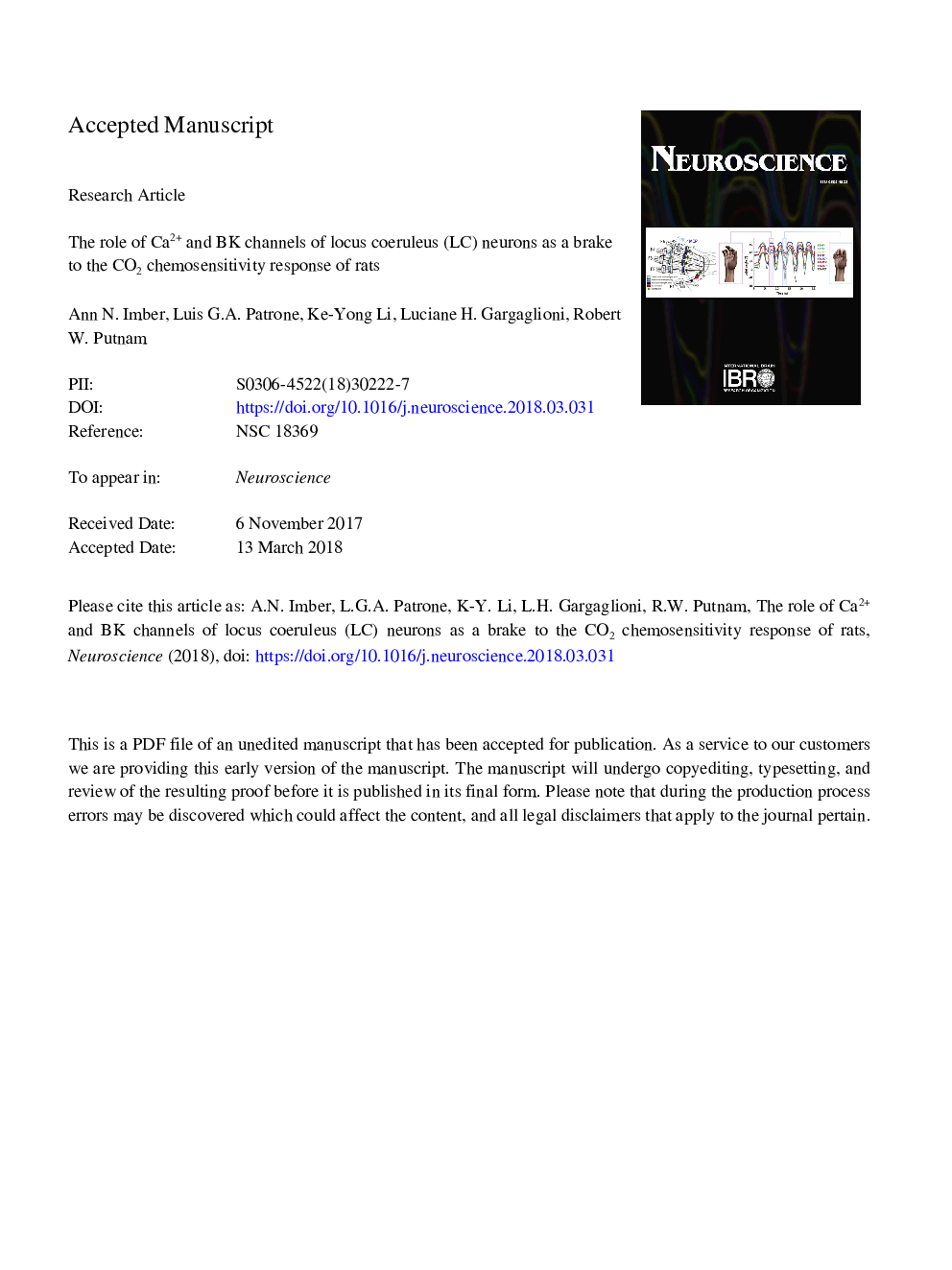| کد مقاله | کد نشریه | سال انتشار | مقاله انگلیسی | نسخه تمام متن |
|---|---|---|---|---|
| 8840726 | 1614695 | 2018 | 69 صفحه PDF | دانلود رایگان |
عنوان انگلیسی مقاله ISI
The Role of Ca2+ and BK Channels of Locus Coeruleus (LC) Neurons as a Brake to the CO2 Chemosensitivity Response of Rats
دانلود مقاله + سفارش ترجمه
دانلود مقاله ISI انگلیسی
رایگان برای ایرانیان
کلمات کلیدی
PO2PAPTTXaCSFKCaPaxillineRTNpCO2EGTANTSPHAHEPESArterial pHTrparterial oxygen partial pressure4-(2-hydroxyethyl)-1-piperazineethanesulfonic acid - 4- (2-hydroxyethyl) -1-piperazineethanesulfonic acidHCO3− - HCO3-ethylene glycol tetraacetic acid - اتیلن گلیکول تتراستیک اسیدPanic disorder - اختلال هراسOxygen - اکسیژنBicarbonate - بی کربنات، هیدروژن کربناتBAPTA - بیایپیتیایPulmonary ventilation - تهویه ریهTidal volume - حجم نزولیCNS - دستگاه عصبی مرکزیBody temperature - دمای بدنCarbon dioxide - دیاکسید کربنDevelopment - رشدpostnatal day - روز پس از زایمانcentral nervous system - سیستم عصبی مرکزیHeart rate - ضربان قلبCapacitance - ظرفیت خازنیHydrogen ion concentration - غلظت یون هیدروژنrespiratory frequency - فرکانس تنفسیpulsatile arterial pressure - فشار خون شریانmean arterial pressure - فشار متوسط شریانیlocus coeruleus - لوکوس سیرولئوسartificial cerebral spinal fluid - مایع مغزی نخاعی مغزیFiring rate - نرخ آتشmap - نقشهnucleus tractus solitarius - هسته دستگاه انفرادیRetrotrapezoid nucleus - هسته ی RetrotrapezoidMembrane potential - پتانسیل غشاء transient receptor potential - پتانسیل گیرنده گذراCO2 - کربن دیاکسید
موضوعات مرتبط
علوم زیستی و بیوفناوری
علم عصب شناسی
علوم اعصاب (عمومی)
پیش نمایش صفحه اول مقاله

چکیده انگلیسی
The cellular mechanisms by which LC neurons respond to hypercapnia are usually attributed to an “accelerator” whereby hypercapnic acidosis causes an inhibition of K+ channels or activation of Na+ and Ca+2 channels to depolarize CO2-sensitive neurons. Nevertheless, it is still unknown if this “accelerator” mechanism could be controlled by a brake phenomenon. Whole-cell patch clamping, fluorescence imaging microscopy and plethysmography were used to study the chemosensitive response of the LC neurons. Hypercapnic acidosis activates L-type Ca2+ channels and large conductance Ca-activated K+ (BK) channels, which function as a “brake” on the chemosensitive response of LC neurons. Our findings indicate that both Ca2+ and BK currents develop over the first 2â¯weeks of postnatal life in rat LC slices and that this brake pathway may cause the developmental decrease in the chemosensitive firing rate response of LC neurons to hypercapnic acidosis. Inhibition of this brake by paxilline (BK channel inhibitor) returns the magnitude of the chemosensitive firing rate response from LC neurons in rats older than P10 to high values similar to those in LC neurons from younger rats. Inhibition of BK channels in LC neurons by bilateral injections of paxilline into the LC results in a significant increase in the hypercapnic ventilatory response of adult rats. Our findings indicate that a BK channel-based braking system helps to determine the chemosensitive respiratory drive of LC neurons and contributes to the hypercapnic ventilatory response. Perhaps, abnormalities of this braking system could result in hypercapnia-induced respiratory disorders and panic responses.
ناشر
Database: Elsevier - ScienceDirect (ساینس دایرکت)
Journal: Neuroscience - Volume 381, 15 June 2018, Pages 59-78
Journal: Neuroscience - Volume 381, 15 June 2018, Pages 59-78
نویسندگان
Ann N. Imber, Luis G.A. Patrone, Ke-Yong Li, Luciane H. Gargaglioni, Robert W. Putnam,